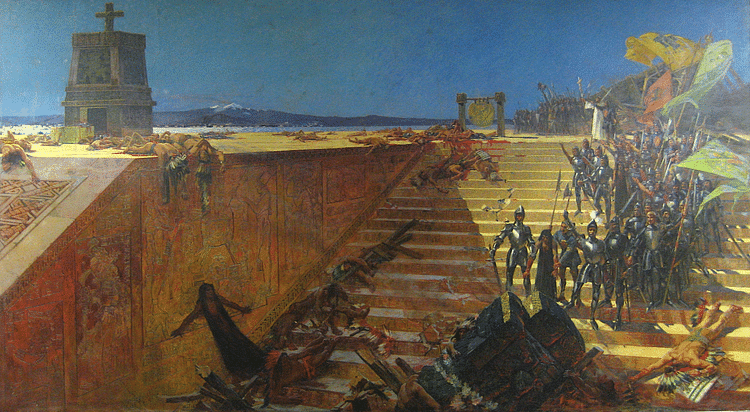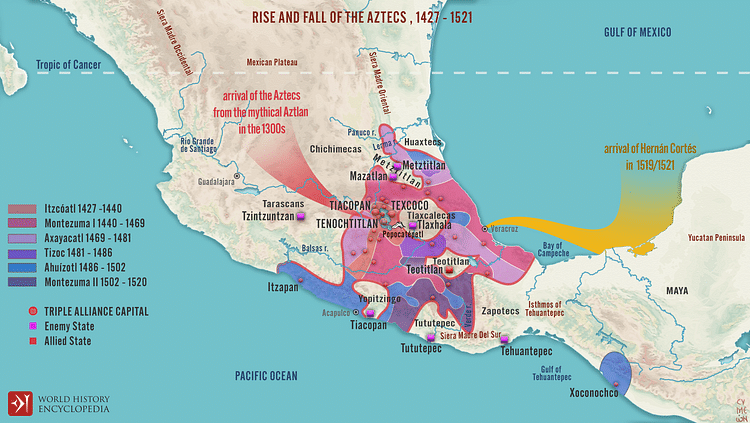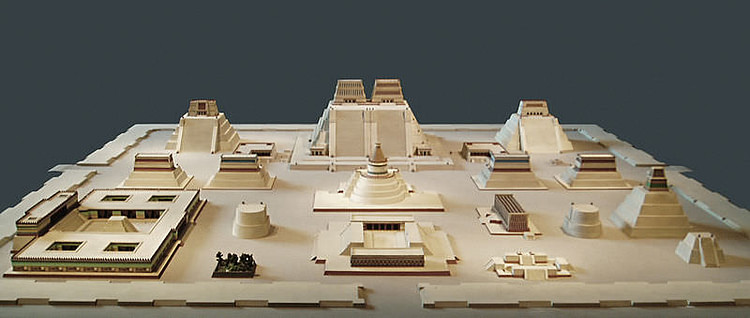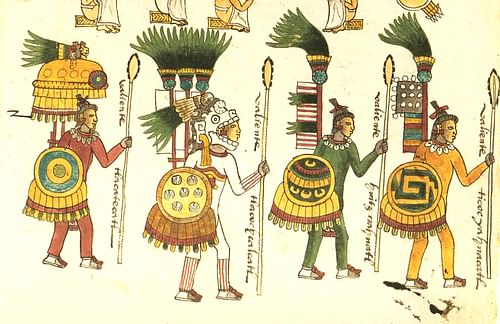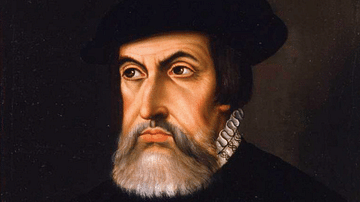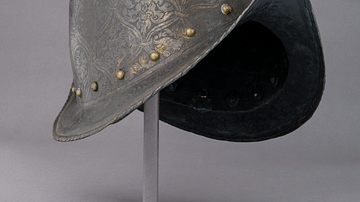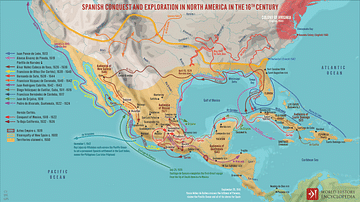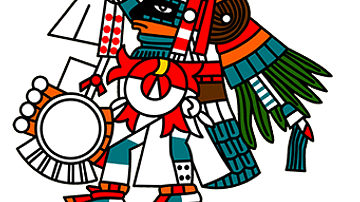The fall of Tenochtitlan on 13 August 1521 was a decisive moment in the dramatic collapse of the Aztec empire which had dominated Mesoamerica. Led by Hernán Cortés (1485-1547), the Spanish conquistadors enjoyed superior weapons and tactics. In addition, the Old World visitors brought with them terrible new diseases that caused massive loss of life amongst the indigenous Americans.
The Aztecs (or Mexica) were themselves a conquering people, and this meant that many of the cities they had subjugated were only too willing to join forces with the Spanish. Tenochtitlan was the political and religious capital of the Aztec world, and the defenders put up a prolonged and fierce resistance. Victory for the Spanish and their allies meant the looting and destruction of this once great city, the largest in the Americas, but it was eventually rebuilt and became what is today Mexico City.
The Aztec Empire
By the early 15th century, several mini-empires had formed in the Valley of Mexico. The dominant cities were Texcoco, capital of the Acholhua region, and Azcapotzalco, capital of the Tepanec. These two city-states came face to face in 1428 with the Tepanec War. The Azcapotzalco forces were defeated by an alliance of Texcoco, Tenochtitlan, the capital of the Mexica, and several other smaller cities. Following victory, a Triple Alliance was formed between Texcoco, Tenochtitlan, and Tlacopan, a rebel Tepanec city, and this trio forged an empire. Over time, Tenochtitlan came to dominate the Alliance, its leader became the supreme ruler – the huey tlatoque ('high king') – and the city established itself as the capital of the Aztec Empire, which now covered 135,000 square kilometres and governed some 11 million people.
The Aztec Empire was a successful one, but it was built solely on coercion and extracting tribute from conquered peoples. Subjugated communities were obliged to give wealth and men for the Aztec military machine. In addition, a significant number of captives of war were taken to Tenochtitlan for ritual sacrifice to the Aztec gods. Aztec religion, art, and officials were forced upon conquered regions. All of this meant there was no shortage of hatred for the Aztecs amongst the Mesoamericans. Nor had the Aztecs conquered all before them. The Tarascans and Tlaxcalans, in particular, continued to probe at the borders of their empire. This inherent fragility in Aztec affairs would prove to be their downfall when the Spanish conquistadors arrived on Mexican shores.
Cortés & the Conquistadors
In 1518, Diego Velázquez de Cuéllar, the governor of Cuba, had dispatched Hernán Cortés to lead 11 ships and 500 men to explore the coast of what is today Mexico. They landed in March 1519. Superior weapons, cavalry, and tactics ensured easy Spanish victories against any hostile peoples they encountered. A significant bonus was the capture of Malintzin (aka Marina, Malinali, or La Malinche), a Maya woman who spoke the Nahuatl language of the Aztecs and a local Mayan language, which one of Cortés' men was familiar with. The invaders could now communicate with potential allies. The Aztec ruler Motecuhzoma (aka Montezuma, r. 1502-1520) soon got news of these troublesome invaders. Cortés, meanwhile, established a garrison at Veracruz on the coast and ordered his ships to be grounded and broken up to remind his men they were here to find riches or die. He promptly marched inland in August 1519, first battling the Tlaxcala (who then became allies) and then pressing on to Tenochtitlan in November.
Tenochtitlan
Located on the western shore of Lake Texcoco, the Aztec capital of Tenochtitlan had over 200,000 inhabitants, making it the largest city in the Pre-Columbian Americas. It covered some 12-14 km² and was connected to the western shore of the lake and surrounding countryside by three causeways (running north, east, and west,) which included gaps traversed by removable bridges to allow boats to pass.
The conquistadors were permitted to enter the city peacefully on 8 November, and they marvelled at the massive temples, flower and water gardens, canals, and street markets of trade goods that came in from all corners of Mesoamerica. Motecuhzoma and Cortés met and exchanged gifts. The Aztec ruler may have been wary of these visitors, having heard of their earlier military victories, but he seemed undecided what to do with them. Diplomacy, in any case, went out of the window two weeks later, when Cortés took Motecuhzoma hostage on 14 November. The Spanish wanted treasure, and the Aztec ruler was obliged to swear himself a subject of the king of Spain, Charles V, Holy Roman Emperor (r. 1519-1556). There were other indignities like a crucifix being set up at the top of the sacred Aztec pyramid, the Templo Mayor.
Cortés now had his own problems, though. He had exceeded his authority in moving in on the capital and so upset Velázquez back in Cuba who, technically, held the sole right to conquest in Mexico. Keen to preserve his position, Velázquez sent a force under the command of Pánfilo de Narváez to Veracruz to apprehend the now-rogue conquistador. Cortés was obliged to leave Tenochtitlan and meet these rivals for future treasure, and so, in May 1520, he left Tenochtitlan in the hands of a small Spanish force under the command of Pedro de Alvarado.
Alvarado and his men proved rather insensitive to Aztec conventions when they unwisely attempted to interrupt a ceremony of human sacrifice and then massacred members of the Aztec nobility. The Aztecs rose up and killed a number of the interlopers. Meanwhile, Cortés defeated Narváez and persuaded his remaining men to join him. They returned to Tenochtitlan on 24 June where a handful of Spaniards were still holding out.
La Noche Triste
Motecuhzoma was replaced by Cuitláhuac as the new Aztec leader after Cortés had foolishly released him from imprisonment. Cuitláhuac had immediately taken over rule of the Aztecs from his captive and now dishonoured brother. Cuitláhuac organised a total war against the conquistadors. When the Spanish tried to use Motecuhzoma to bring calm to the situation, the former leader was struck by a rock and killed on 30 June. The Spanish became trapped in the royal palace of Axayácatl and the target of missiles sent down from the towering Tempo Mayor. A fierce battle ended in Cortés taking control of the Temple of Yopico, which he then set fire to, horrifying the population. Cortés then fled the city in a running night battle on 30 June 1520. This bloody retreat became known as the Noche Triste ('Sad Night'). The Spaniards had extricated themselves using temporary wooden bridges built for the challenging task of crossing the city's many canals, but the price of freedom was high. Cortés had lost half his men, most of his best horses, and all of the eight tons of loot he had been accumulating ever since he arrived in Mesoamerica.
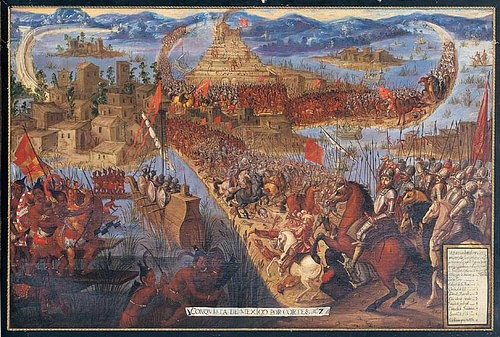
The Siege
Before reaching the safety of Tlaxcala territory, Cortés first had to win a great battle near Otumba on 7 July, where the Aztecs tried once and for all to wipe out the foreign invaders. After several more campaigns, and receiving reinforcements by sea, the Spanish eventually returned to Tenochtitlan ten months later to gain their revenge and cut out the heart of this empire that had created so many enemies in Mesoamerica no one would join it in the war against the invaders. First, Texcoco was taken on 31 December 1520 and became an invaluable base and source of supply for Cortés. Other cities were taken over the next three months as the Aztec grip on the area around their capital loosened.
Cortés' plan was now to lay siege to Tenochtitlan, but already another, far more terrible enemy had swept through the Aztec population. There had been a devastating outbreak of smallpox in the previous September and November. The Aztecs also had a new leader, Cuauhtémoc, after Cuitláhuac himself had succumbed to the new imported disease.
In April 1521, Cortés began his siege. His force included 700 infantry, 118 crossbowmen and harquebusiers, 86 horses, and 18 field guns – most useful for destroying enemy barricades. The Spaniards were organised into four divisions. Their weapons were swords, halberds, and crossbows. Cortés also had at his disposal a number of indigenous Cubans and African slaves, and a number of mastiff attack dogs. Most significantly of all, the Spanish had native allies, notably at least 100,000 Tlaxcalans. On the other side, the Aztecs were numerically superior but had only obsidian-bladed weapons, bows, spear-throwers, and slings, all of which were effectively (if not completely) neutralised by European body armour.
A further disadvantage for the defenders was the strategies traditionally employed in Aztec warfare. Elite warriors and officers usually made themselves conspicuous with their costume, and the Spanish were not slow to first eliminate the leaders and so cause panic in the Aztec army. Overcoming the deficiencies of their weapons, the Aztec warriors fought ferociously and with courage, as noted by the Spanish themselves. They did also adapt to the new challenges of European warfare – avoiding open ground where cavalry dominated, scattering away from the potential arc of fire of gunpowder weapons, and even tying captured Spanish steel blades to poles to make a weapon that their enemy greatly feared. The battle for Tenochtitlan was going to be one much more evenly matched than previous encounters.
On 28 April 1521, Cortés deployed a fleet of 13 specially built warships on Lake Texcoco. These vessels, never before seen by Mesoamericans, were built from the great ships Cortés had ordered wrecked two years before and new supplies from Veracruz. They had been constructed prefabricated so that they could be transported by land to the lake. With these ships, Cortés was able to counter the many thousands of native canoes and block the three main causeways which linked the city to the edges of Lake Texcoco. Each brigantine carried 25 men plus six carrying crossbows and harquebusiers. The Spanish ships were escorted by a large fleet of canoes manned by their allies from Texcoco.
On 22 May, three columns of conquistadors headed into Tenochtitlan, one from the west, one from the south, and the third from the east. Cortés left the north side unblocked, hoping to catch any fleeing Aztecs with his main cavalry force. As it happened, the Aztecs used this route to bring in supplies and so Cortés sent a force to close it off. On 26 May, a company led by Alvarado destroyed the Chapultepec aqueduct, cutting off the defenders' supply of fresh water (the water of the lake was brackish). On 1 June, the warships attacked and made light work of the Aztec canoes even if some had been reinforced with extra wooden shielding. Only one Spanish ship got into difficulties after it ran aground and was temporarily overwhelmed. As more and more indigenous allies joined the attack, the great city of Tenochtitlan began to crumble as the defenders were pushed back to its central core.
In June, Spanish forces made it to the ceremonial heart of the city, but twice they were obliged to withdraw, burning buildings as they moved back. A third attack led by Alvarado on 23 June was also pushed back, and a fourth led by Cortés himself on 30 June was defeated with heavy losses for the Spanish. For a few moments, Cortés was actually captured, but the Aztec tradition of taking live captives rather than killing an enemy there and then spared his life, and he was rescued by his comrades. The fighting had been fierce now for one month, as the chronicler and participant Bernal Díaz (c. 1498 to c. 1580) notes in his celebrated account, The Conquest of New Spain:
As for our captains and our standard-bearer and his guard, they were covered with wounds and their standards were ragged. Indeed, I should say that we needed a new standard-bearer every day, for we were so badly battered that no one could carry the standards into battle a second time.
(365)
Those 50 or so Spaniards who had been captured in the debacle of 30 June were marched naked to the top of the Great Pyramid of Tlatelolco and had their hearts cut from their chests in sacrifice to the Aztec gods. The drums, conch shells, and dreadful screams of this ceremony could be heard by Cortés and his conquistadors, who remained powerless to intervene.
The Aztecs next went on the attack and moved out of the city centre to raid the Spanish camps. Meanwhile, Cortés' allies began to melt away as their home cities began to be attacked by Aztec forces and their leaders succumbed to the propaganda of Cuauhtémoc sending them dismembered body parts of fallen Spaniards as evidence the Old World invaders were far from being invincible. Consequently, a force of conquistadors was dispatched to aid Cuernavaca and Sandoval, both of which were relieved. These victories reminded everyone of the military superiority of the Spanish, and their indigenous allies began to return to the main cause: the siege of Tenochtitlan.
Final Victory
The defenders still had a few strategies left to employ. They built barricades and widened and deepened their canals. They scattered large stones in the open plazas so that the Spanish cavalry would find the terrain more difficult to fight upon. They also used the tight urban spaces well, preparing holes in walls so that warriors could move around with ease and not be pursued by a mounted enemy. The siege was taking its toll, though. Starvation, the lack of fresh drinking water, and the incessant attacks meant that many of the defenders began to defect or surrender.
The attackers were determined and relentless. Cortés also received an invaluable boost in men and resources when the expedition of Juan Ponce de León (1474-1521) landed at Veracruz on its return from exploring Florida. Grabbing more and more of the city, square by square, by 25 July, the Spanish had captured the great market and temple of Tlatelolco and so now controlled all of the city except one small area of continued resistance. They had used gunpowder to systematically blow up buildings to clear lines of fire for their cannons and permit greater freedom of movement for the cavalry.
Finally, on 13 August, after 93 days of resistance and long out of food and weapons, Cuauhtémoc surrendered, but only after being captured while trying to make his escape in a canoe. Tenochtitlan was sacked, looted, and its monuments destroyed. The Tlaxcalans were ruthless in their revenge and slaughtered men, women, and children wholesale, even shocking the hardened Spanish veterans with their atrocities. The Spaniards, meanwhile, looted everything and everyone in their search for gold.
From the ashes of the disaster at Tenochtitlan rose the new capital of the colony of New Spain, and Cortés was made its first governor in May 1523. The capital had fallen, but the Spanish were required to campaign in other parts of the crumbling Aztec Empire until 1525. As the Mesoamerican way of life was systematically repressed and land was parcelled out to the conquerors, Tenochtitlan, with its great lake drained off, gradually morphed into Mexico City, capital of the Viceroy of New Spain.
